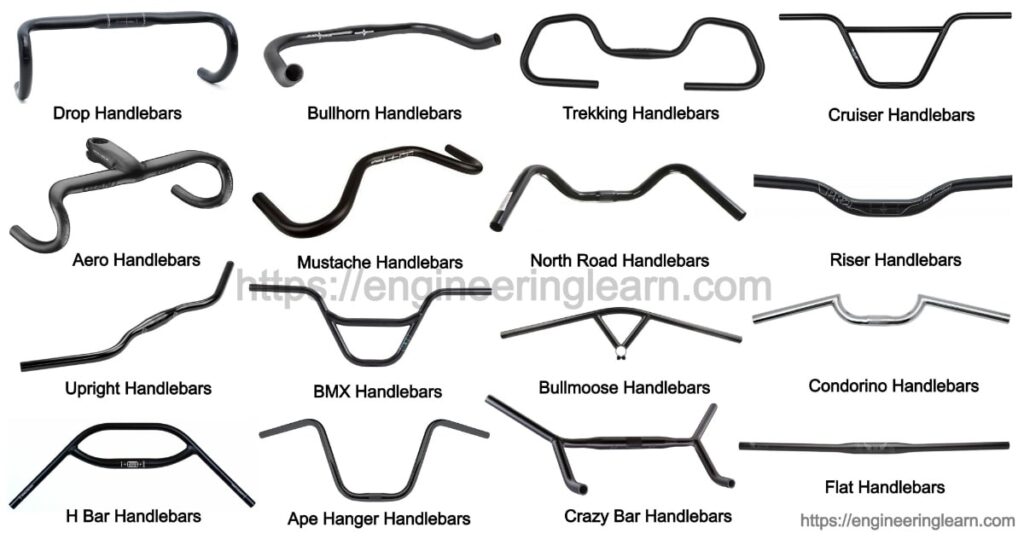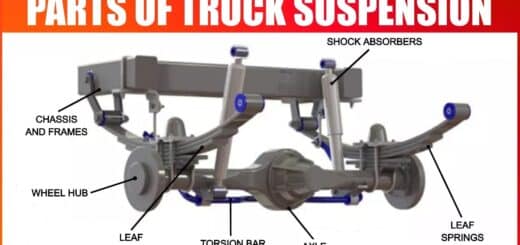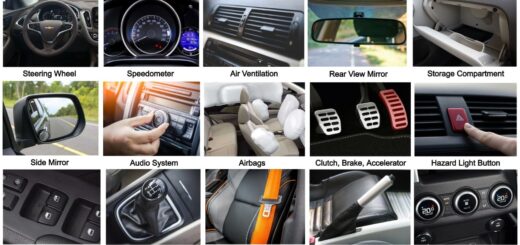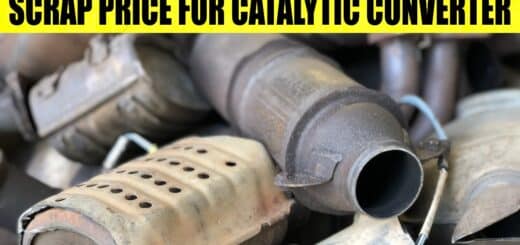15 Types of Handlebars for Bikes & Motorcycles [Complete Details]

What is Handlebars?
Types of Handlebars: Bikes & Motorcycles :- The handlebars are referred to as those which play a very major role in the comfort, aerodynamics, and handling of your bicycle. Other than steering the bike, the handlebars are also known to be the support part of your weight whenever you ride. Other than this, they are found providing a mounting location for your brake levers and shifters as well as accessories like a light, cycling computer, GPS, etc.
15 Different Types of Handlebars
This content is written with an aim to make you learn about the types of handlebars which are mostly used in the handlebars.
1. Flat Handlebars: ( Types of Handlebars )
Flat handlebars are referred to as one of the most basic type of bicycle handlebars. These handlebars are popularly found on the mountain bikes, hybrids, cross-country bikes, flat bar road bikes, and fixed-gear bikes.
Flat bars are mostly found with a simple tube which is nearly straight. Most of the bends slightly move back towards the rider varying from 2 and 10 degrees. The angle of bar bending backwards is referred to as sweep. The flat bars are usually found in a range of widths whereas the average pair measures approximately 580-600 mm in width.
Pros of Flat Handlebars
A) Offer Good Control
The flat bars are found to be wide in terms of dimensions which gives you a lot of leverage. The steering can be precise even at the lower speeds or on at the technical terrain. This is the reason of excessive usage of such handlebars in the mountain bikes.
B) Easy Parts Availability
If you are really fond of using your cycles in the rural region or the developing world then it would be easy for you to find the flat bar which is found having compatible brake levers, shifters and the cables. Mostly all the bike repairing shops are found having them in stock.
C) Easy Braking
While cycling you need to keep your hands near to the brake levers which helps you in stopping the bike faster in any immediate situation as you will not have time to move your hands to any other part of the bars in order to reach the levers.
Cons of Flat Handlebars
A) Poor Aerodynamics
Flat handlebars are mostly those which put you in an upright riding position. In this type of position, your chest will act as a sail which can cause a drag. This is the reason for slowing your speed down.
B) No Efficiency
The poor aerodynamics is the reason due to which you need to burn more energy in order to maintain your pace. Particularly when you are riding through a headwind or at lower speed.
2. Drop Handlebars: ( Types of Handlebars )
Drop handlebars are referred to as those bars which feature a straight center section where the bars are found attached to the stem. The ends of the bars are found to be curved forward, then downwards and then finally back towards the rider. These are known to be one of the most popular types of bicycle handlebars which are resurgent in the market today. These can be commonly found in the road bikes, racing bikes and even at some of the off-road bikes.
Types of Drop Handlebars
Drop bars are most commonly found in a number of different styles for varying types of cycling. These are commonly defined by three popular measurements:
Reach– Reach is responsible for measuring the analytics of the far forward bar curves.
Drop– Drop is responsible for measuring the distance within the top and the drop of the graph.
Width– Width is responsible for measuring the distance within the drops.
It is important to note that all these measurements are commonly listed in either centimeter or millimeter.
Pros of Drop Handlebars
A) Apt Aerodynamics
Drop handle bars usually help you to crouch down so that the drag can be reduced. This is the reason why the rider can ride faster and can also save energy.
B) Various Hand Positions
There are three main hand positions: On the brake hoods, on the top of the bars, and in the drops. The fourth position which is found on the curve is on the top of the bars.
C) Perfect for Hill Climbing
These handle bars help you in shifting your weight in the forward direction. This is the reason which gives you more leverage to let you pedal more powerfully.
Cons of Drop Handlebars
A) Costly Parts
It is commonly known that the drop bar brake levers and shifters are one of the most expensive parts as compared to the flat bar versions.
B) Less Control on Bike
As the drop handlebars are found to narrower, they are hard to steer precisely. This is the reason why the drop bars are usually better in terms of the road usage.
C) Poor Parts Availability
Whenever you ride in the rural regions or any such region which is developing then you might find it difficult to find replacement parts for instance the brake levers and shifters. This causes a difficulty wherein the parts if damaged cannot be found again in the market.
3. Bullhorn Handlebars: ( Types of Handlebars )
Bullhorn bars are referred to as those handle bars which are curved in the front direction and are found up at the ends. The shape which it forms is a sort of U shape from which they have got their names. These types of handlebar were originally used in order to track racing and now a days they are popular on the fixed gear, single-speed and urban commuting bikes.
These are the ones which drop down slightly from the center and then gets curved out which moves up at the ends similar to a bullhorn bars. This is the handlebar which gives you a more aggressive as well as aerodynamic position for riding the bicycle efficiently.
Pros of Bullhorn Handlebars
A) Commendable Aerodynamics
Bullhorn bars are referred to as those handlebars which help you to crouch down in case of the headwinds and also during riding at a speed by gripping the bar ends. The bullhorn bars are not as aerodynamic as compares to the drop bars but are much better than then the flat bars.
B) Perfect for Climbing
Gripping the bar helps you in moving your weight forward which gives you a great leverage in terms of climbing hills. This respective position is responsible for giving you an optimal pedaling power. This is the reason why the bullhorn bars are usually found to be the best type of handlebars for fulfilling the purpose of climbing.
Cons of Bullhorn Handlebars
A) Not Apt for Sharp Turns
As it is a narrow design, the rider cannot get much chances of precise turning. This is the foremost reason why bullhorn bars are not found to be ideal for the off-roading rides.
4. Riser Handlebars: ( Types of Handlebars )
Riser bars are referred to as those bars which can be known as one of the varying version of flat bars. The only difference which is commonly known about riser bars is that the riser bars sweep up from the system before flattening out on the ends where the grips are placed.
Typically they are found to rise within 15-50 mm. The riser bars are mostly found to be wider as compared to the flat bars as well. Most of these are found measuring about 650-800 mm in width.
The main purpose of these handlebars is to keep you in more upright riding position as compared to the flat bars. Many people are found to be quite comfortable in such positions. Riser bars are known to be quite common on hybrid bikes, mountain bikes and comfort bikes.
Pros of Riser Handlebars
A) Excellent Controlling
Riser handlebars are responsible for giving you a lot of leverage in order to accurately point your bars wherever you want to go. This results in making them great for the purpose of riding on the uneven surfaces too and at a comparatively lower speed.
B) Undoubtable Comfort
Most of the riders observe that the upright riding position needs to be more comfortable as compared to the aggressive hunched over the position.
C) Gentle on Wrists
As the rider is in an upright riding position, this can take your body weight off your wrists and arms which can even move to your butt. This is found to be great for those people who are found having the wrist problems.
Cons of Riser Handlebars
A) Poor Aerodynamics
Once you are sitting straight up, your chest is responsible for creating a lot of wind resistance which results in slowing down the speed and directly costs you more energy. Therefore, it is difficult to tuck down in order to reduce the drag while using the riser bars.
B) One Hand Position Only
Whenever you are riding at longer distances, you can experience hand fatigue or numbness. This is because you cannot change your grip up. An easy solution to this constraint is to install bar ends for a second-hand position.
C) Heavy
The rise along with its width is increased which means that there is a need of more material which shall be needed in order to manufacture the bars. This is responsible for making it heavier.
5. Aero Handlebars: ( Types of Handlebars )
Aero bars are referred to as those handlebars which are designed in order to put your body in the most aerodynamic riding position as much as possible technically. This is achieved by drawing the body in to the forward direction and then into a tucked position where the arms of the rider are found to be held out in front of them. The Aero bars are mostly popular in all the time trial events and triathlons where the riders race against the clock instead of the other riders.
Aero bars are found to consist of mostly two parallel bars which are mounted to close together that extend straight out in front of the rider. Most of the aero handlebars are found sweeping up slightly at the ends in order to make them more ergonomic due to which they are often wrapped in bar tape.
Pros of Aero Handlebars
A) Excellent Aerodynamics
These are the most efficient handlebars according to aerodynamics. The position of the rider allows you to cut through the air by simply reducing the drag. To this if the aero bars are added, then it can surely increase the speed and efficiency.
B) Clip-Ons Can be Added
The aero bars can be mounted to most of the handlebar types which can include handlebars like drop bars, flat bars and bullhorn bars.
C) Rider Can Rest their Hands
While riding through the aero bars, the rider does not really even need to use their hands much. There is no need to grip the bars, most of the time as your forearms help you in keeping them straight.
Cons of Aero Handlebars
A) Unstable
Holding the hands being a rider so near makes it quite difficult to turn it. Due to this the rider does not get the leverage to turn precisely. If you wish to make quick turns, then you might put yourself in a really dangerous situation.
B) Not Easily Accessible Braking System
The rider needs to take an immediate decision for applying the brakes, as takes time to push the hands of the rider off the aero bars and then move it to the braking system which again seems to be quite dangerous. In case you need to stop quickly then you must not waist even a single moment.
C) Not for Sprints or Climbs
Sometimes power is more important than aerodynamics. In this type of case, the aero bars will not be able to help you.
6. Cruiser Handlebars: ( Types of Handlebars )
Cruiser bars are referred to as those handlebars which sweep up towards the back of the bicycle diagonally. The idea of such design is to allow the rider to sit in a completely upright position. These types are commonly found on beach cruisers which use the same shifters and brake levers as the flat bars.
7. Trekking Handlebars: ( Types of Handlebars )
Trekking bars are also commonly termed as butterfly or touring bars which are referred to as those designs that give you a wider range of hand positions in order to keep you comfortable on longer distances. These are those types which are mostly common on touring most commonly the European made touring bicycles.
Trekking bars are found having a breaking system on the side closest to the rider where the grips go. Trekking bars are found using the same brake levers and the shifters as the flat handlebars.
8. Mustache Handlebars: ( Types of Handlebars )
Mustache handlebars are referred to as those which start curving forward from the stem and then curve backwards in the direction of the rider. The ends of the bars are found to drop down slightly, which gives the rider a bit of an aero position. These are found having the looks like the drop bars.
Mustache bars are the ones which use the same brake levers and shifters as the drop handlebars. These handlebars are found to be compatible with the integrated shifters or bar-end shifters. The road style brake levers are mostly mounted sideways, inside the crest of each and every curve.
9. Upright or North Road Handlebars: ( Types of Handlebars )
North road handlebars are referred to as those handlebars which are found curving forward slightly from the stem and then sweeps backwards in the direction of the rider. In most of the cases, the grips are found to be parallel to the frame of the bike. Mostly these handlebars sweep up varying from 3-4 inches. These handlebars are found to be inverted to let them sweep down. This is responsible for giving the bike a more aggressive riding position.
North road bars are known to be one of the oldest handlebar designs. They got their names from a London’s North Road Cycling Club. These handlebars have grown in popularity these days and are high in demand. These types of handlebars are commonly found in bikes like town bikes, commuters, city bikes, hybrid bikes, comfort bikes, utility bikes and roadsters.
10. Ape Hanger Handlebars: ( Types of Handlebars )
Ape hangers are referred to as the hangers which rise up from the stem in a U shape. These are usually found to be so high that the rider has to reach up in order to grip them which means that the grip is found to be above the shoulder level. In the extreme cases, the grips can even sit above the head of the rider.
Ape hangers are specifically designed in order to imitate the look of the chopper motorcycles. This is the type of bike handlebar which is found to be popular from the year 1960. Ape hangers were found to be popular throughout the mid-1980s. After that they were known as the lowrider bicycles.
For the purpose of safety, there were certain laws passed in the year 1970, in order to limit the height of ape hanger handlebars which were commonly installed by manufacturers.
The maximum height of ape hanger was fixed to be around 16 inches or 40.64 cm above the lowest seat setting. After which the limit of the height was fixed in different countries depending upon the lowest seat setting.
11. H Bars: ( Types of Handlebars )
H bars are the only handlebars which are found in a variety of designs. The main thing which creates a different in these handlebars from other designs is the sweepback at an angle of 45-degree. Most of the models are found having a unique loop design in the center accompanied with a rise of 0.5 inch.
These handlebars are found to be available in the materials like aluminum, carbon and titanium. H bars are found to be a popular choice as the touring bikes, gravel grinders, mountain bikes, fat bikes, road bikes, commuters and bike packing bikes.
12. BMX Handlebars: ( Types of Handlebars )
BMX handlebars are referred to as those handlebars which are found having a rise of 8-10 inches from the stem which then levels off at the ends where the grips are found to be placed. Most BMX handlebars are found to have a crossbar in the middle which helps in providing an extra strength as well as rigidity.
These handlebars are specifically designed in order to let the rider handle hard use. This is responsible for giving the rider a stable base for performing various tricks.
BMX handlebars are measured using its dimensions in terms of width, rise and sweep up. Most of the BMX handlebars are found to rise up to 8-10 inches which can measure 28-30 inches in width.
13. Bullmoose Handlebars: ( Types of Handlebars )
Bullmoose bars are referred to as those handlebars which are found to combine the handlebars and quill stem into one single unit. There are found to be two diagonal bars which run from the quill to the handlebars. These two stem bars are responsible to meet the handlebars off-center, which tends to form a triangle. The actual handlebar is mostly found to be flat accompanied with a slight sweep back from where the stem actually meets the bar. Bullmoose handlebars were quite popular in the early mountain bikes and therefore are not used much in the modern bikes.
14. Condorino Handlebars: ( Types of Handlebars )
Condorino handlebars are referred to as those handlebars which are unique in terms of looks and have a short straight section near the stem which is usually found to be curved forward at an angle of 90°. From this point, they are found turning sharply outwards at an angle of almost 90°.
Condornino bars became popular in Italy in the year 1950 which were specifically designed in order to give the bike a nice sporty look and to also let it be useful for the general riding purpose. Particularly at that time, most of the people could not afford a racing bicycle.
This was the reason that Condorino bars lost popularity as road bicycles were found to have more popularity as compared to these handlebars. The production of such handlebars went out of production in the year 1980.
15. Whatton Handlebars: ( Types of Handlebars )
Whatton bars are referred to as those handlebars which are designed so that the rider can land their feet first, in case they need to bail from the bike. This was only possible as the desired shape was achieved of the bars. Whatton handlebars are known to be used on the recumbent bicycles with under seat steering as well.













